Into the Stormtroopers. Part One
Today’s post has nothing to do with wine. This is part one of a true story about a presidential assassination attempt, the American Nazi Party and personal regret. In light of recent events it seemed an appropriate time to tell the tale. All photographs ©1981 Donald Carter.
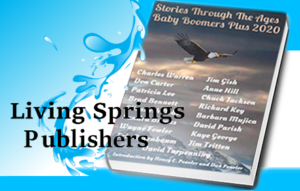
NOTE: “Into the Stormtroopers Part One and Part Two” was published in Living Springs Publishers anthology, Stories Through The Ages Baby Boomers Plus 2020.
“This is a must-read story about the tumultuous events that abruptly thrust Don Carter into the international spotlight and an adventure of a lifetime … Don’t miss this gripping, page-turning mystery about events that every baby-boomer will remember. Don won second prize with his story.”
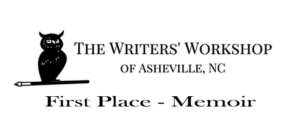
NOTE: “Into the Stormtroopers Part One and Part Two” is the First Prize winner in the 2017 Writer’s Workshop of Asheville “Memoir” competition.
“… writing style is impressive, and the descriptions were vivid. The content is gripping, unusual and page-turning!” The Writer’s Workshop of Asheville.
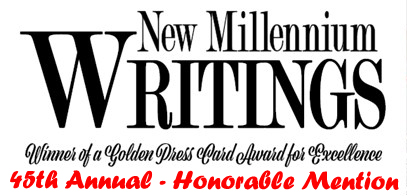
NOTE: The literary journal New Millennium Writings awarded this article Honorable Mention.
Of White Power and White Guilt
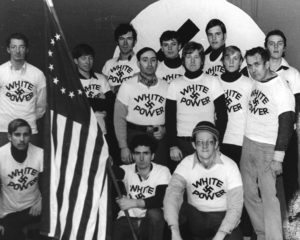 As a younger man I seldom gave thought to motivation or consequence. I felt compelled to take risks – to seek out the dark places and walk with the beasts – but the nearest I came to reflection was when I inevitably picked myself up, checked for injuries and wondered, “What the hell was I thinking?”
As a younger man I seldom gave thought to motivation or consequence. I felt compelled to take risks – to seek out the dark places and walk with the beasts – but the nearest I came to reflection was when I inevitably picked myself up, checked for injuries and wondered, “What the hell was I thinking?”
As an older man I’ve struggled with the emotional fallout that comes from second-guessing one’s actions but despite some feelings of regret, I believe my raison d’être was well intentioned. I like to think I climbed under the bed in the middle of the night, faced the monsters and dragged them into the light so that we might all better understand the hatefulness that grows in the shadows we choose to ignore.
When I was a freshman at the School of the Art Institute of Chicago I set out to expose these darker places. Little did I suspect that the images I captured would one day attract international attention and the FBI, subpoena in hand, would come looking for the monsters I uncovered.
More on that later.
*****
November 1974
It was one of those November days in Chicago. The savage wind and rain – whipped into a predatory frenzy by the whitecaps on Lake Michigan – stalked victims up and down Michigan Avenue. It was a dismal, atheist rain, just one degree short of converting to sleet.
It was a perfect day for hunting Nazis.
I turned my back against the rain and prayed my knit cap and raised collar would help sell my disguise. The term skinhead hadn’t yet come into vogue but I was fairly certain a longhair would not be welcome inside Nazi Party headquarters. I was trying to look like a rough and tumble longshoreman but suspected I looked more like Mike Nesmith of the Monkees.
The target of my photo-documentary was an organization calling itself the National Socialist Party of America (NSPA), which rumor held was headquartered in the Marquette Park neighborhood on the city’s far south side. White supremacist Frank Collin formed the NSPA in 1966 after being dismissed from the National Socialist White People’s Party (NSWPP) which had evolved from the original American Nazi Party founded by George Lincoln Rockwell. In a few years Collin would become the subject of extensive media coverage when he announced the NSPA, dressed in full Nazi Stormtrooper regalia, intended to march through Skokie, Illinois, home to a vast enclave of Holocaust survivors.
The streets of Marquette Park were deserted when I arrived. Its shoe cobblers, TV repairmen and fortunetellers had closed their doors against the repugnant weather and its residents had taken refuge behind thick, faded curtains. The aging, old-world population seemed reluctant to give up its secret but when I found myself staring gape-mouthed at George Lincoln Rockwell Hall I realized the NSPA was not the clandestine operation I had expected.
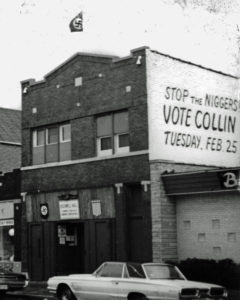 Rockwell Hall had the unmistakable look of a Nazi Party headquarters. The two-story brick fortress was built with steel reinforced doors, barricaded windows, and a swastika banner flying high above the pediment. But the real giveaway, the images that jolted me like a jackboot to the solar plexus, were the brazen racist messages broadcast across the second story walls.
Rockwell Hall had the unmistakable look of a Nazi Party headquarters. The two-story brick fortress was built with steel reinforced doors, barricaded windows, and a swastika banner flying high above the pediment. But the real giveaway, the images that jolted me like a jackboot to the solar plexus, were the brazen racist messages broadcast across the second story walls.
I stood frozen before the reinforced door, my inertia finally broken when a group of goose-stepping Nazis marched up the street and a fresh regiment of goose pimples marched down my spine. The placards they carried spewed loathsome messages and their shirts bore the stark, unmistakable likeness of a swastika encircled by the words “WHITE POWER”.
There’s a scene in The Wizard of Oz in which the Scarecrow, Tin Man and Cowardly Lion slip into the Wicked Witch’s castle by following the Winkie Guards through an imposing gate. As they fall in line behind the last guard the Cowardly Lion vainly attempts to conceal his tail inside his coat. Like some absurd Winkie parody the Nazis marched past me and entered single file into their fortress. I confirmed that my own tail (that is to say my ponytail) was safely hidden inside my coat and then I fell in line behind the last Nazi and slipped into the claustrophobic confines of Rockwell Hall.
When the disconcerting thud of a dead bolt sounded behind me the stale air seemed to press in like the thick, muffled atmosphere inside a decompressing airplane. With my head down to avoid eye contact I ricocheted off brusque neo-Nazis who seemed oblivious to my presence. It hadn’t occurred to me that they might think of me as just another hate-mongering teenager and for the time being my mission remained hidden.
The room was dim and the musky air was laced with radioactive levels of testosterone. I wandered past drab walls punctuated with racist posters and feigned interest in dilapidated racks spilling over with anti-Semitic propaganda. On the farthest wall there hung an illuminated Nazi Party flag. In the monochromatic gloom its brilliant red and white hues shown like the glowing embers from a thousand burning books.
NSPA leader Frank Collin was middle-aged, diminutive and balding. He could have been the neighborhood butcher or insurance agent if not for the swastika on his arm and the pistol on his hip. Collin was rallying his troops for a propaganda blitzkrieg when I approached and revealed the camera hidden beneath my coat. He slowly sized me up as the voices in the room took on the guttural resonance of a pride of mountain lions eyeing their prey and doing the math. In Collin’s unreadable eyes I felt the monster’s invisible arms slither around my chest and send my lungs chasing air.
Frank Collin was many things, including a candidate for the local alderman’s seat. His unambiguous campaign slogan – WHITE MAN FIGHT – was plastered on the side of Rockwell Hall four decades before populist politicians would develop coded language to relay the same message. I recovered my breath and reminded Collin of a politician’s need for exposure (my stomach lurched as the stark propaganda films of Leni Riefenstahl sprang to mind). He broke from his deliberation and summoned his men to pose before the flag for a quick group shot – just like one big happy Aryan family.
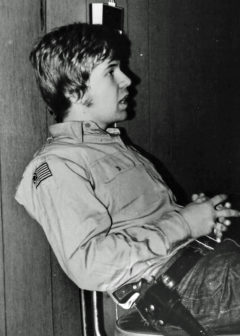 After Collin’s troops dispersed I took a seat next to a quiet man wearing a brown shirt and a black gun. The young Nazi had the abbreviated syntax of a man uncomfortable talking to others but when I asked about his pistol he brightened and unholstered the weapon. He emptied the bullets from their chambers and lined them up on the desk before me. “See how the tips are hollowed out?” he asked. “They’re called ‘dum-dum bullets’. They expand on impact to inflict maximum damage.”
After Collin’s troops dispersed I took a seat next to a quiet man wearing a brown shirt and a black gun. The young Nazi had the abbreviated syntax of a man uncomfortable talking to others but when I asked about his pistol he brightened and unholstered the weapon. He emptied the bullets from their chambers and lined them up on the desk before me. “See how the tips are hollowed out?” he asked. “They’re called ‘dum-dum bullets’. They expand on impact to inflict maximum damage.”
The term was new to me. In a few years dum-dum bullets would enter the national vocabulary (and the national debate on gun control) when a gunman would fire a similar bullet into the President of the United States.
I guiltily continued my charade as an enthusiastic pupil and gradually pried open the door into the young man’s guarded isolation. As he coddled the powerful weapon in his hands a subdued self-satisfaction began to lubricate his speech.
“Dum-dum bullets make a small hole when they go in, but a BIG hole when they come out.”
His disarming demeanor was the antithesis of his unsettling words. Here sat a soft-spoken young man, marginally older than me, a man who came of age during the summer of love, flower power and the peace movement, and yet some unknown circumstance had led him down this dark, hateful path. He calmly spoke about killing with the emotional velocity typically reserved for ordering lunch. I imagined this carnal exchange, cold steel on warm flesh, would somehow deliver the psychological carbohydrates needed to feed his inner demons and sustain him through another day.
As the other Nazis returned to Rockwell Hall I again felt the feral air compact around me. I longed to escape into the frigid Chicago dusk but I hadn’t produced “the shot” – the one powerful image that captured the essence of my experience. In other words, I had yet to drag the monster out from under the bed and into the light.
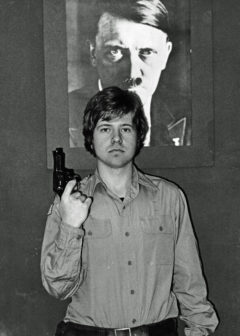
The young Nazi stood before a portrait of Adolf Hitler and slowly raised his gun, passing it inches from my face. For one vivid, frozen moment I looked into its chambers and faced the hollowed-out tips of six deadly bullets.
Click.
The monster was captured on a 35-millimeter prison of film.
*****
My mind has replayed the hours spent inside NSPA headquarters many times over and while the conversations have faded from exact recall, I still remember the hollow feeling of remorse that followed me home that day. It wasn’t Frank Collin or the young neo-Nazi with the bullet fetish that upset me. It was my own clandestine façade, my own revolver of guilt that fired the hollow-tipped bullets of shame into my psyche.
I let a group of white supremacists believe that I was one of them because the urge to do otherwise was suppressed by a well-developed survival instinct. George Orwell once cautioned, “He wears a mask and his face grows to fit it”. I didn’t think I was in danger of succumbing to an outbreak of racism or catching some neo-fascist infection. All of my liberal inoculations were up to date. No, the sepsis crawling beneath my skin was more like the associative guilt that Michael Herr described in his Vietnam memoir Dispatches; “I went there behind the crude but serious belief that you had to be able to look at anything, serious because I acted on it and went, crude because I didn’t know, it took the war to teach it, that you were as responsible for everything you saw as you were for everything you did.”
Time spent in the company of white supremacists infects the soul with white guilt; a cultural remorse derived from membership in a race that has for centuries, slaughtered, enslaved and banned people of color. The catalyst of the guilt gnawing at my consciousness was the memory of how I so eagerly and easily sold my disguise. It was the liability of this deception that quietly chafed at my moral sensibilities for years and it was the unresolved culpability of omission that eventually metastasized into a malignant lump of regret.
*****
I had no idea how far my photo documentary would travel when I walked out of George Lincoln Rockwell Hall but in hindsight there was a great deal I didn’t know that day. I didn’t know that Frank Collin would win a frightening 16% of the primary vote in his bid for public office or that these same Chicago Nazis would gain international notoriety when the Supreme Court would allow them to demonstrate in Skokie, Illinois. I didn’t know that Collin would eventually be ousted from power when he was exposed as the son of Jewish immigrants or that he would go to prison for molesting young boys inside Nazi Party headquarters.
And I most certainly didn’t know that the FBI, armed with a subpoena, would visit my office in search of the monsters I held captive on a tiny strip of film. It wasn’t Frank Collin they were seeking. They were looking for the quiet young Nazi with an unhealthy gun infatuation; a man who possessed an even stronger infatuation with a young actress named Jodie Foster. The FBI was chasing the murky past of John W. Hinckley Jr., the disturbed gunman who shot down President Ronald Reagan and three others on a Washington D.C. sidewalk.























Fascinating background details of a historic event that will always be a blemish on our nation. Well written and timely given the current political climate. Thank you for once again being informative and entertaining!
Thanks Rita. Funny how an event can touch so many lives. I doubt that in 1981 you thought you would be waking up a friend to tell him his photographs and name were splashed across the front page. Sorry about the “metallic voice” – I meant the telephone, not you!